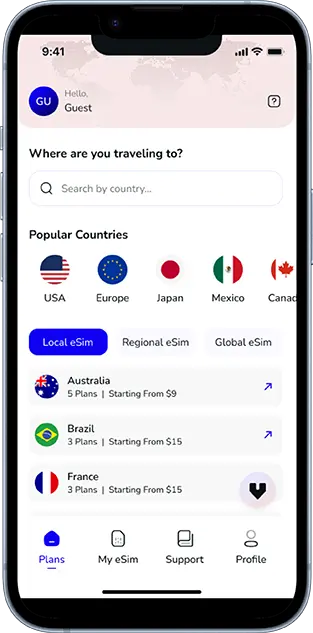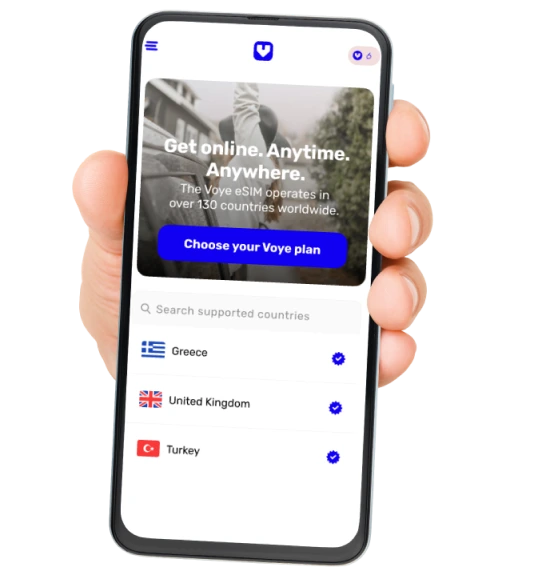Note that iPhone devices from Mainland China aren’t eSIM compatible. Also iPhone devices from Hong Kong and Macao aren’t compatible (except for iPhone 13 Mini, iPhone 12 Mini, iPhone SE 2020 and iPhone XS)
Air travel can be thrilling, but it’s also filled with potential stress points—especially when you’re unsure of how early to arrive at the airport. Should you arrive three hours ahead? Two? Is one enough for domestic flights? And what about international travel, connecting flights, or traveling during holidays?
In this comprehensive guide, we’ll break down everything you need to know about airport arrival times, so you can enjoy a smooth and stress-free travel experience.
Global Coverage, Local Rates
Experience hassle-free connectivity wherever you go.
Why Airport Arrival Time Matters
Airport processes like check-in, security screening, baggage drop-off, and boarding can vary in duration depending on a variety of factors. Missing your flight can cost money, create unnecessary stress, and derail travel plans. Arriving on time not only ensures you won’t miss your plane but also gives you time to deal with unexpected delays like long security lines or traffic jams on the way to the airport.
General Guidelines for Airport Arrival
Here are standard recommendations for when to arrive at the airport:
- Domestic Flights: Arrive at least 2 hours before departure.
- International Flights: Arrive at least 3 hours before departure.
- Peak Travel Periods or Large Airports: Add an extra 30–60 minutes.
- No Checked Bag & Mobile Check-In: You may shave off 30 minutes.
Always verify with your airline, as guidelines can differ depending on the carrier or airport.
Domestic Flights: How Early Should You Get There?
For domestic travel, arriving 2 hours in advance is a widely accepted rule. But this can depend on:
- Airport Size: Larger hubs like LAX or JFK have longer security lines.
- Airline Requirements: Some budget airlines require earlier check-ins.
- TSA PreCheck or Clear Membership: Speeds up security, may allow arrival 90 minutes before departure.
Also, consider how far your gate might be, especially in sprawling terminals.
International Flights: When to Arrive
International travel involves more rigorous checks—passport control, visa verification, potential customs forms. Arrive at least 3 hours early, particularly if:
- You’re flying to countries with strict immigration.
- You’re traveling with large groups or children.
- You need to check in at the counter due to document verification.
Allowing this buffer ensures you’re not scrambling through passport control at the last minute.
Your Journey, Our eSIM
Stay online abroad with instant activation.
Traveling with Checked Luggage vs. Carry-On
Checked Luggage: You must arrive earlier—airlines often close baggage drop 45–60 minutes before departure.
Carry-On Only: You can save time by checking in online and heading straight to security. In this case, 90 minutes for domestic or 2 hours for international may be sufficient, but don’t cut it too close.
Pro Tip: If you’re using an eSIM for mobile data, you can access boarding passes and flight status updates on the go, even in international airports.
Early Morning and Late-Night Flights
Early morning flights often have less crowded airports but can still attract a rush due to multiple flights departing in a short window. Arrive at least 90 minutes to 2 hours early.
Late-night or red-eye flights tend to have shorter lines, but services like public transport or rideshares may be slower. Don’t assume you can breeze through security—give yourself the standard buffer.
Busy Travel Seasons and Holidays
During holiday seasons, summer breaks, or long weekends, airports experience significant delays.
Plan to arrive:
- 3+ hours before domestic flights
- 4+ hours for international flights
Increased crowds mean longer waits at check-in and security. Booking lounge access or priority services can help ease the wait.
Traveling with Kids, Seniors, or Special Needs
Traveling with companions who may need extra assistance? Add 30–60 extra minutes to your usual arrival time.
Why?
- Kids can slow down check-in and security lines.
- Seniors may need wheelchairs or additional help.
- Travelers with special needs may go through alternate procedures.
Most airports have dedicated counters or fast-track lanes for families—look out for these options.
First-Time Flyers: Extra Time Needed?
If it’s your first time flying or your first visit to a particular airport, arrive at least 30–60 minutes earlier than recommended.
Familiarity matters. Finding your terminal, understanding signs, or even locating restrooms can take more time when everything is new.
Tip: Download your airport’s terminal map and install your airline’s app. With eSIM data, you can access these tools without worrying about roaming charges.
How to Check Real-Time Airport Conditions
Use the following to monitor airport status before heading out:
- TSA Wait Times App or Website: For U.S. airports.
- Your Airline’s App: Often gives gate info, delay notifications.
- Google Maps or Waze: Check traffic to the airport.
- FlightAware or FlightRadar24: Track your flight’s schedule in real time.
Traveling internationally? Stay connected using Voye Global eSIM—perfect for real-time updates in over 130+ countries without switching SIM cards or paying for roaming.
Mobile Check-In and eSIMs: Tech That Saves Time
Tech can drastically reduce the time you need at the airport:
- Mobile Check-In: Available 24–48 hours before your flight. Skip the check-in counter.
- Digital Boarding Pass: Scan directly from your phone.
- eSIM for Travel Data: Stay connected even before reaching your hotel. Services like Voye Global allow instant data access across borders—perfect for navigating foreign airports.
What Happens If You’re Late?
If you arrive late:
- Less than 45 minutes before departure: You may not be allowed to check bags.
- Less than 30 minutes: You risk missing the check-in window altogether.
- Less than 15 minutes: The gate is likely closed.
What to do:
- Head to a service desk immediately.
- Call your airline en route.
- Rebooking fees may apply, but some airlines offer standby options.
Final Tips for a Smooth Airport Experience
- Set multiple alarms on the day of travel.
- Lay out documents, chargers, and passports the night before.
- Opt for early flights to avoid cascading delays.
- Use travel apps for updates and real-time alerts.
- Invest in an eSIM for seamless mobile connectivity in every airport.
Conclusion
When it comes to air travel, early is always better than sorry. While every traveler’s situation is unique, understanding the standard timelines and variables involved ensures you’re never rushing through the terminal. A well-planned airport arrival sets the tone for the rest of your journey.
From mobile check-ins to global eSIM connectivity with providers like Voye Global, today’s tech makes it easier than ever to arrive early and travel smarter.
So, next time you’re wondering when to head out for the airport—refer back to this guide. Your stress-free, on-time journey awaits.
Global Coverage, Local Rates
Experience hassle-free connectivity wherever you go.
Seamless Mobile Data Everywhere




















